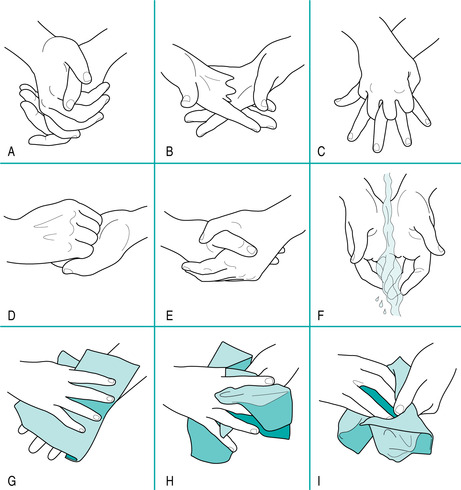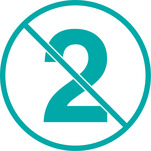Prevention and control of infection is essential to protect patients and healthcare staff in any care setting – hospital, community or the patient’s own home. Prevalence studies in the UK indicate that about 9% of hospital patients acquire an infection during their stay resulting in considerable personal and institutional cost (Walker 2002).
The principles of prevention of infection and control of spread of communicable disease looks at proactive measures that should be practised every day in every setting and consists of three sections:
1. Safe practices
2. Safe environment
3. Procedures for coping with the unexpected
Learning outcomes
By the end of this chapter you should be able to:
▪ apply standard infection control precautions to any care setting
▪ demonstrate to patients, relatives/carers and colleagues the different methods of hand hygiene
▪ be able to explain in simple terms the differences between cleaning, decontamination and sterilisation
▪ report an incident or accident that might result in an infection, e.g. sharps injury.
Background knowledge required
Revision of Standard Infection Control Precautions (see ‘Isolation’, p. 187).
Review local policy regarding the management of outbreak of infection.
Review local policy regarding the reporting of an incident and/or accident.
Access and complete your local hand hygiene training.
Review local policies regarding disinfection and sterilisation.
Indications and rationale for infection prevention and control processes
Many patients will have a pre-existing infection when they present to the healthcare worker in the clinic, at the ward or in an emergency situation. Some infected persons will not be aware of their status, e.g. those with undiagnosed blood-borne virus infection; and others may fear the stigma of their condition, e.g. patients with pulmonary tuberculosis. However, patients will not always appear ‘sick’ and in the early stages of incubation the symptoms of infection may appear vague, misleading or be absent. Healthcare workers should not make assumptions about infection risks and must consistently use standard infection control precautions.
Infection Prevention and Control policies are often closely linked to Risk Management policies and Occupational Health policies, such as:
▪ outbreak of infection management policy
▪ reporting incidents and accidents.
1. SAFE PRACTICES
Principles for these practices
Personal health and hygiene
▪ healthcare workers have legal responsibilities to their clients under theHealth& Safety at Work Act (1974), and if handling food or drink they have a ‘duty of care’ under the General Food Hygiene Regulations (Department of Health 1995). They must not knowingly spread biological hazards that include gastrointestinal and skin infections. Staff illness must be reported to the local Occupational Health Service, if available, and medical advice sought if gastrointestinal symptoms (‘enteric illness’) do not resolve or diminish after 48 hours
▪ certain communicable infections, e.g. salmonella, must be notified under Public Health Legislation and Food Hygiene Regulations and the individual may be required to submit formal ‘clearance’ specimens prior to resuming duties (Department of Health and Social Security, 1984 and Department of Health and Social Security, 1985) to ensure appropriate public health measures can be implemented on a reactive and proactive basis
▪ the nurse must maintain high standards of personal hygiene through daily bathing or showering and keeping hair clean and restrained while at work in clinical settings or food-service environments to ensure they are not the direct or indirect source of cross-infection.
Uniform issues
▪ workplace clothing is provided in most clinical settings and acts as a form of corporate identification as well as ensuring staff have items suitable for undertaking diverse duties, e.g. Accident& Emergency Nurse Practitioners usually wear long sleeved water repellent tops and ‘pyjama type’ bottoms
▪ clean uniforms should be available daily and extra stock kept to utilise if the nurse becomes soiled during the course of the shift. The fabrics of the clothing should be chosen for durability and temperature resilience
▪ items should be laundered on as hot a wash as the materials will tolerate. Some faecal organisms will survive low-temperature washing and so thermal disinfection by ironing is recommended following washing and drying (Patel et al 2006).
Personal protective clothing
▪ items that are provided to protect the nurse undertaking specialised clinical procedures are deemed by the Health and Safety Executive to be ‘personal protective equipment’ (PPE)
▪ formal risk assessment and monitoring must be undertaken to ensure compliance and suitability, e.g. disposable aprons, masks, face visors, gowns and hats used for isolation care, theatre lists and decontamination purposes
Hand hygiene
Hands carry infection from person to person, place to place and family to family. Researchers consistently find that nurses fail to wash their hands when working in clinical settings that they deem to be ‘low risk’ and need frequent reminders to improve practice. The World Health Organization programme (2005)‘Clean hospitals, clean healthcare’ emphasises the key role of this often undervalued activity. The USA Centers for Disease Control (Centers for Disease Control 2002) guidelines, the NHS Education Scotland guidelines (NHS Education Scotland 2005) and the Department of Health/NPSA guidance in the ‘Wash your hands’ campaign (Department of Health 2005) all stress the value of hand hygiene. The forms of hand hygiene (Fig. 19.1) are:
 |
| FIGURE 19.1Handwashing technique |
▪ ensure that hand jewellery is minimised to only a plain wedding ring, remove your wristwatch and roll up sleeves to ensure the whole hand is washed
▪ wet the hands and using liquid soap and warm running water, or a bowl of freshly run water, wash hands thoroughly and check that all surfaces are washed especially the outer aspect of the thumb and smallest finger to ensure all skin surfaces have been washed
▪ dry well using a disposable paper towel.
Aseptic handwashing
▪ using an antimicrobial preparation for aseptic handwashing will remove ‘transient’ or temporary micro-organisms acquired from the environment and contact with other persons from the surface of the nurse’s skin. Some aseptic preparations, e.g. chlorhexidine gluconate, also have a residual effect reducing the ‘resident’ or deep-seated skin flora, which continues for some hours after application and repeated use increases the effects
▪ in order to prevent antimicrobial resistance aseptic handwashing should be reserved for high-risk situations, e.g. where there are outbreaks of infection
▪ aseptic handwashing should be performed at a clinical washhand basin where elbow- or wrist-operated taps can be turned off without touching the tap surfaces.
Surgical scrubbing
▪ the correct technique for washing the hands and forearms (to the elbow) with the approved antimicrobial preparation should be taught to new staff who should then practice under supervision until deemed competent
▪ single use or sterile nailbrushes may be used to clean gently under the nails but care must be taken not to damage the nailbed that could lead to infection of the damaged surface
▪ special deep sinks with elbow- or foot-operated mixer taps are usually used for ‘scrubbing’ to minimise splash contamination of the uniform or environment and prevent recontamination of clean skin.
Alcohol hand rub
▪ alcohol handgel/rub may be used for rapid decontamination of visibly clean skin, after coming out of an isolation area where hands are washed before leaving the room or following social handwashing (Scottish Executive Health Department 2005)
▪ the gel or alcohol rub should be rubbed in until all surfaces are dry using the same hand washing technique as that used for plain soap.
Skin care
▪ nurses must report any possible allergic reactions to soap or gloves to their Occupational Health Service to ensure an accurate health record of the employee
▪ if special products are prescribed to an individual with a known skin condition, e.g. psoriasis or eczema, the product should be labelled for that nurse only and kept in a convenient area in the workplace
▪ advice should be given by the manager of the workplace about any special precautions or exclusions from duties, e.g. if the individual has an acute infected skin condition they may not be able to work with patients with MRSA or to handle foods directly (Health and Safety at Work Act 1974, Health Services Advisory Committee 1999)
▪ all staff must cover cuts, wounds and septic lesions whilst at work to prevent cross-infection. Waterproof, impermeable dressings or gloves may be worn if appropriate (see ‘Isolation nursing’p. 187).
Safe equipment
▪ all equipment purchased and used for healthcare must be ‘fit for purpose’. At the most basic level this means that simple reusable items such as commodes should be designed to be cleaned and disinfected between uses
▪ technical items must be supplied with manufacturer’s guidance and marked clearly to indicate if the equipment is for single use, single-patient use or multiple use and can be reprocessed
▪ single-patient use indicates that an item can be reused by one patient only, e.g. a nebuliser which can be washed in fresh warm water and detergent solution between uses and air-dried (Medical Devices Agency 2000)
▪ single-use items should always display the symbol (Fig. 19.2) indicating no second use or reprocessing (even for the same patient) on the external packaging
 |
| FIGURE 19.2Universal symbol for single use |
▪ medical devices are specialised items of equipment such as catheter bags. These products are regulated by legislation and monitored by national and international agencies such as the Medical Healthcare Regulation Agency (MHRA) in the United Kingdom.
2. SAFE ENVIRONMENT
Principles for these practices
Patient placement
▪ this is one of the key practices relating to prevention and control of infection. In modern hospitals elective high-risk surgery patients are usually segregated from persons with known infections (see ‘Isolation nursing’p. 187)
Get Clinical Tree app for offline access



